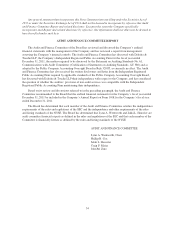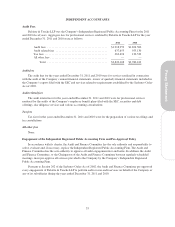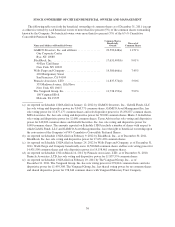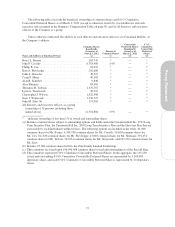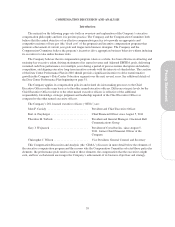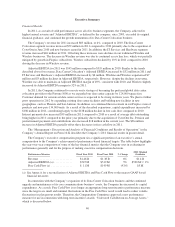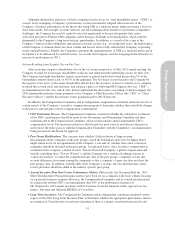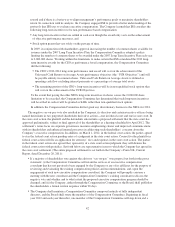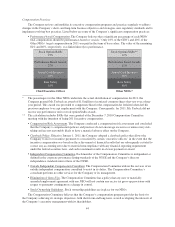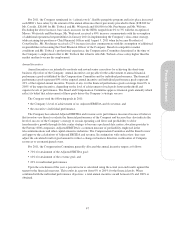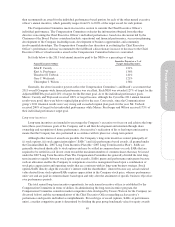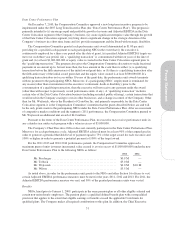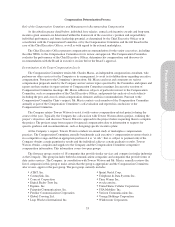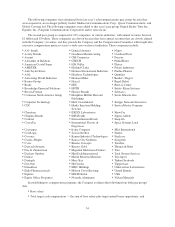Cincinnati Bell 2011 Annual Report Download - page 58
Download and view the complete annual report
Please find page 58 of the 2011 Cincinnati Bell annual report below. You can navigate through the pages in the report by either clicking on the pages listed below, or by using the keyword search tool below to find specific information within the annual report.
Compensation Practices
The Company reviews and modifies its executive compensation programs and practices regularly to address
changes in the Company’s short- and long-term business objectives and strategies, new regulatory standards and to
implement evolving best practices. Listed below are some of the Company’s significant compensation practices:
•Performance-based Compensation. The Company believes that a significant percentage of each NEOs’
total compensation should be performance-based or “at-risk.” Only 18% of the CEO’s and 40% of the
Other NEOs’ target compensation in 2011 was paid in the form of base salary. The value of the remaining
82% and 60%, respectively, was linked directly to performance.
Stock Options/SARs
27%
Stock Options/SARs**
12%
Performance Based Awards
27%
Performance Based Awards
12%
Annual Cash Incentive
28%
Annual Cash Incentive
36%
Base Salary
18%
Base Salary
40%
Chief Executive Officer Other NEOs*
* The percentages for the Other NEOs understate the actual distribution of compensation. In 2011, the
Company granted Mr. Torbeck an award of $1.8 million of restricted common shares that vest over a three-
year period. This award was provided to compensate him for the compensation he forfeited when left his
previous employer to accept employment with the Company. Consequently, for 2011, Mr. Torbeck did not
receive any performance unit or stock option/SARs awards.
** The calculation includes SARs that were granted at the December 7, 2010 Compensation Committee
meeting with the intention of being 2011 incentive compensation.
•Compensation Risk Assessment. The Company conducted a compensation risk assessment and concluded
that the Company’s compensation policies and practices do not encourage excessive or unnecessary risk-
taking and are not reasonably likely to have a material adverse effect on the Company.
•Clawback Policy. Effective January 1, 2011, the Company adopted a clawback policy that allows the
Company to recover incentive payments to or realized by certain “executive officers” in the event that the
incentive compensation was based on the achievement of financial results that are subsequently restated to
correct any accounting error due to material noncompliance with any financial reporting requirement
under the federal securities laws, and such restatement results in a lower payment or award.
•Independent Compensation Committee. Each member of the Compensation Committee is independent as
defined in the corporate governance listing standards of the NYSE and the Company’s director
independence standards mirror those of the NYSE.
•Outside Independent Compensation Consultant. The Compensation Committee utilizes the services of an
outside independent compensation consultant to assist in its duties. The Compensation Committee’s
consultant performs no other services for the Company or its management.
•Elimination of Gross-Ups. The Compensation Committee has a policy that any new or materially
amended employment agreement with any NEO will not contain any excise tax gross-up provisions with
respect to payments contingent on a change in control.
•Stock Ownership Guidelines. Stock ownership guidelines are in place for our NEOs.
The Compensation Committee believes that the Company’s compensation program provides the basis for
the Company achieving its strategic objectives, both short-term and long-term, as well as aligning the interests of
the Company’s executive management with its shareholders.
44


